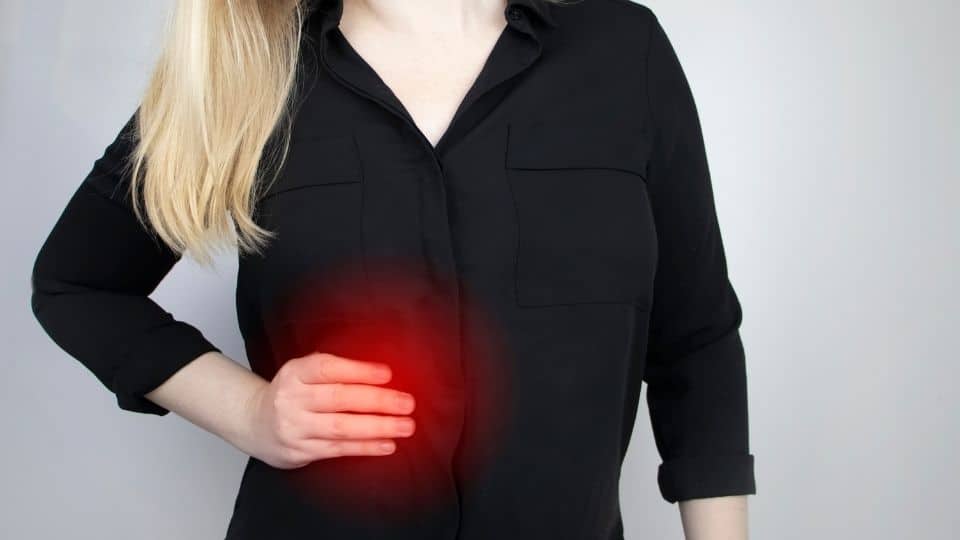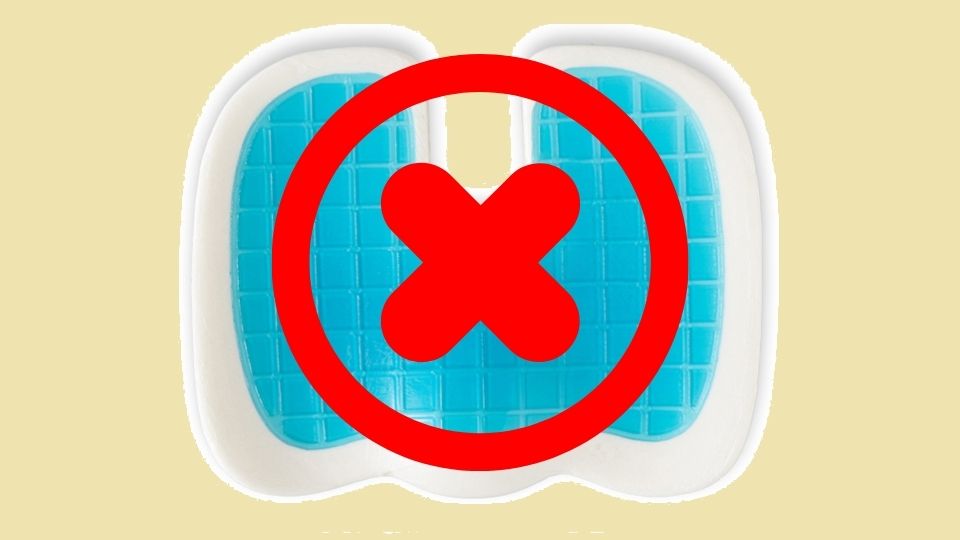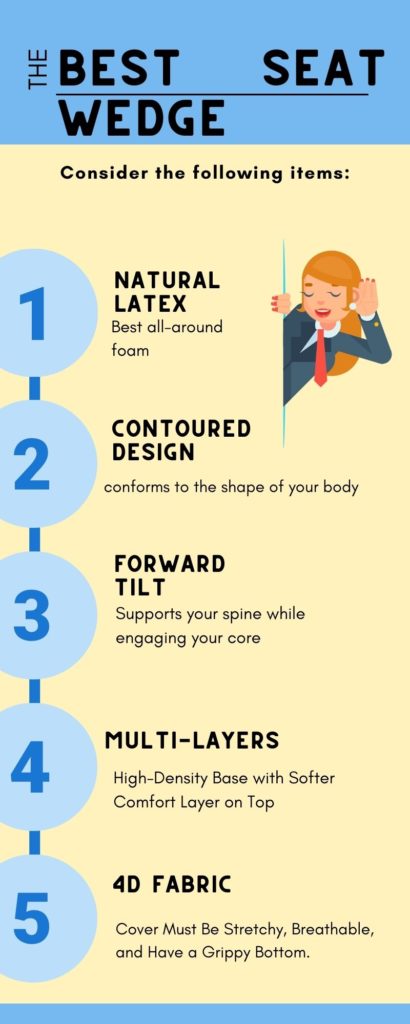If you’ve been experiencing chest pain, it’s essential to rule out possible causes. Many people think poor posture is only responsible for neck and back problems, but did you know it can also lead to rib pain? In this blog post, we’ll discuss how poor alignment can cause chest pain and tips on improving your posture. Keep reading to learn more!

As a general rule, poor posture, poor posture can cause injury to the spinal and rib joints, resulting in stress on muscles and ligaments. In addition to pinched nerves, stiffness, and even a loss of balance, bad posture can have several other effects. A proper diagnosis is crucial.
In this article, I will give you reasons why bad alignment can cause chest pain, based on my 30 years of advising, treating patients with similar conditions, researching, and designing simple solutions (even a successful Kickstarter campaign!), and I even published a book on this subject.
All Day Comfort & Support
You need more than just good alignment to maintain good health. In addition to pinched nerves, bad posture can cause stiffness in other parts, such as the arms, leading to balance problems! One common side effect people fail to consider: is rib pain caused by noncardiac issues related directly to how we walk–our “posture.”
Have you ever been sitting at your desk for hours, hunching over to look more closely and carefully study the work before you, only for it to become painful? It’s pretty standard. When our bodies often twist (as most of us do), there can be issues with certain joints, such as those found near or around one’s backside, which may lead to pain if not dealt with by medical professionals who know what they are doing!

The point here isn’t just about physical ailments, though. At the same time, some illnesses have connections between different parts of an individual body–such as how migraines might be linked to neck tension–and there can also be an emotional aspect to these pains. After all, not only our physical health suffers when we’re stressed out or anxious! Emotional pain manifests differently for different people, but one of the most common signs is tense muscles, which can cause discomfort.If you find yourself often experiencing pain in different parts of your body, it might be time to see a doctor or a therapist. However, there are also some things that you can do on your own to help alleviate the pain.
Black Friday: 35% Off Today
Typical Delivery 1-3 Days
Here are a few suggestions to alleviate chest or rib pain:
- Maintain good posture when sitting, and avoid slouching or hunching over.
- Take regular breaks to move and stretch your body. Movement is key!
- Consider using comfortable seating or ergonomic seat cushions.
- Try relaxation techniques like deep breathing exercises.
Best Tip for Chest Pain due to Poor Posture
A poor sitting alignment is the most common cause of muscular chest pain or rib pain, according to my professional experience. The following is a simple fix that I prescribe for my patients, and you will thank me later:
The use of an orthopedic seat wedge can help adjust your spine into a more optimal position while sitting and engage core muscles. This is an easy solution!
I explain the concept of an orthopedic seat cushion on a TV show HERE!
An orthopedic seat wedge can be used to improve your sitting experience. It raises the angle of your upper legs relative to your torso, providing a better surface to sit on. Wedge cushions can provide a better sitting experience, but it’s important to maintain good posture while using them. When used correctly, they can help to distribute weight and reduce stress on the joints, discs, and ligaments in the spine.
I was surprised how similar cheap memory foam seat cushions were on Aliexpress and FAKE REVIEWS from the listing on Amazon!
Seat Cushions for Chest Pain: Five Things to Consider
Foam for a chest pain-relieving seat cushion:
Cushions made of gel
The polymer material is used to make flat or contoured gel cushions. These cushions are designed to not flow or move like liquid gels, and the plastic container will not be damaged if ruptured. However, these gel cushions may not provide much shock absorption or pressure relief. They have been tested on many users and were found to not provide much comfort in terms of pressure point relief. These prototypes scored the lowest in comfort (-90%) in our ‘in-house’ comparison to other designs.
Cushions made of memory foam
NASA developed a shock-absorbent material that was originally intended for use in protective gear for astronauts such as helmets and padding. However, it was later rejected by NASA due to concerns about the release of gases from the material.
Here’s why you shouldn’t use memory foam as a seat cushion:
- A lack of responsiveness. Using a responsive cushion will help improve the seating experience. Foam responsiveness measures the speed and degree of a foam’s response to pressure.
- Heat-retaining. Memory foam tends to retain more heat than other types of foam which can be uncomfortable when seated.
- Petroleum-based. Polyurethane, a by-product of crude oil refining, is used in memory foam.
- The use of certain chemicals. Some memory foams may contain harmful compounds such as polyurethane, formaldehyde, antimony trioxide, PVC, and petrochemicals.
- Additional fire retardants. Due to regulations, Memory foam mattresses may contain more fire-retardant chemicals than before.
All Day Comfort & Support
Natural Latex Foam
Among a variety of seating materials and products, natural latex is my favorite choice. Here’s why:

- Spinal alignment. Natural latex seat cushions can promote better spinal alignment. The pressure distribution of the cushion allows for the heavier parts of your bottom to sink into the latex while the lighter parts are kept aligned naturally, which can improve comfort while sitting.
- Non-toxic. Natural latex seats differ from memory foam cushions because they are made from natural materials.
- Eco-friendly as well. Hevea Brasiliensis trees are harvested for their sap in sustainable latex farming, and newly planted trees replenish ageing trees.
- Adaptable. Natural latex has allowed me to design many custom products, which is why chiropractic and ergonomics have always been my favorite fields.
- Good air circulation. As with most conventional memory foam (petrochemical-based), natural latex foam provides better comfort.
- Latex is entirely biodegradable and recyclable. Buried latex cushions can decompose in landfills.
- Release of pressure. Latex can also align your spine and alleviate pressure points.
- Resilient. Typical natural latex seat cushions prevent you from sinking into them too much after a certain point and rebound as you apply your body weight. This is what makes natural latex so unique.
Best Design for an Orthopedic Seat Cushion for Rib Pain:
This (picture above) is a relatively simple seating cushion design that is becoming the most popular but wrapped in fancy marketing jargon and a new look.
The backs of some seat cushions are better than those of others. For a comfortable seat cushion design, you should take into account the following factors:
- As you sit, all those bony prominences between your legs are the first place the cushion touches you. In order to reduce sitting pain, successful cushions, including those that reduce pressure points, redistribute pressure away from sensitive areas of the pelvis.
- A seat cushion will change shape when you sit on it. For example, the softer the foam, the more likely it is to compress and “bottom out”.
- Your seat cushion should be multi-density foam to support and distribute pressure. The top layer should be soft and padded.
- When seated on molded cushions, the body conforms to its shape. These cushions should provide adequate support to the bony prominences to increase the trunk-to-thigh ratio.
- You should be able to engage your core while you sit on a seat cushion that supports your spine. Although it may seem counterintuitive, you will be more comfortable when your weight is distributed into your core instead of your spine. We always receive positive feedback from our patients after making this adjustment to their seat cushions!
Black Friday: 35% Off Today
Typical Delivery 1-3 Days
What Is the Best Cushion for Rib Pain?
Rib Pain From Spinal Bending Versus Hip Hinging
You can make your office chair more comfortable by using wedge cushions or sitting on specially shaped-wedges or foam cushions. With the cushion’s slight downward slope, you can sit up straighter and relieve aches in the mid back and ribs. You will bend from your hips and not your spine in this position.
There Are Many Other Benefits of a Sitting Wedge:
- Hips rule! Your pelvis will be moved forward, using your hips instead of your back to lift!
- Proper posture improves core stability,
- Long-term sitting is made more comfortable with ergonomic seat cushions.
- Aids in relief for coccyx injuries – tailbone discomfort
All Day Comfort & Support
How Do You Use A Wedge Cushion?
It is as simple as lying on your back and lifting yourself up! Find the thicker part of the chair back. The wedge will allow your back to remain upright. Couches and armchairs can’t be used with orthopedic wedges.
Other Posture Problems That Can Lead To Chest or Rib Pain
The most likely cause of rib pain is upper-crossed syndrome or UCS. Due to an imbalance in your shoulders and back muscles, the tendons that run along your shoulders and back are overused while others get tightened from lack of use, causing stomach discomfort since you’re not using one side properly!
Medical professionals finally recognize that sitting all day at a desk can have adverse health effects. An estimated 50% of white-collar workers yearly suffer from work-related neck or shoulder disorders! We need to consider the increasingly sedentary nature of many jobs when designing our office environment so that they don’t contribute to bad posture habits that could eventually lead to WNSDs.
By moving around frequently during each task, you can heal and take short breaks between large amounts of work.
Black Friday: 35% Off Today
Typical Delivery 1-3 Days
Respiratory problems
Let’s take a look at what happens when we breathe in. As you inhale, the diaphragm moves down and compresses against abdominal muscles, pushing up with all its might; this tension creates pressure within us, so our lungs feel like they’re filling easier than before! Healthy individuals will notice an increase in how much air gets into them and where it feels like there’s space for more oxygen – inside or outside?
When you breathe in, your lungs expand, getting trapped inside. If they’re not expanded enough or compressed by an incorrect posture, this can lead to rib pain!
A condition known as precordial catch.
The cause of precordial catch syndrome, or PCS, is still being debated by scientists. One theory suggests it can be caused by a pinched nerve or muscle strain deep in the chest. Still, there have also been connections between poor posture and this phenomenon, including just sitting up straight affecting how quickly symptoms go away- so you should try not to slouch when possible!
Can a Bad Alignment Lead to Rib Pain and Shortness of Breath?
As a general rule, it is possible that bad posture can cause chest pain and shortness of breath. This is because bad posture can pressure the lungs and heart, making breathing difficult.
If you are experiencing chest pain and shortness of breath, you must see a doctor to rule out other potential causes. Treatment for poor posture may include exercises, stretches, and/or wearing a supportive device. Surgery is rarely needed. With proper treatment, most people experience significant improvement in their symptoms.
Can Bad Posture Affect Your Heart?
As a general rule, bad posture can affect your heart. Poor posture puts extra strain on your heart and can make it work harder than it needs to. This can lead to problems such as high blood pressure and arrhythmias.

In addition, bad posture can also cause chest pain and shortness of breath. If you have any heart condition, it is vital to maintain good posture and keep your heart healthy.
How Do You Know if Chest or Rib Pain Is Muscular?
As s general rule, the key thing to look for when determining if the chest or rib is muscular is whether the pain worsens with activity or specific movements. Does pressure on the affected area reproduce the pain if the pain is localized to a particular area? Then it’s very likely that your chest or rib pain has a muscular source.
A muscular chest and rib pain is often aggravated by deep breathing, coughing, or sneezing. It’s also important to note that muscular chest and rib pain are usually not accompanied by shortness of breath, heart palpitations, or sweating. If you’re experiencing any of these other symptoms and chest or rib pain, it’s essential to see a doctor immediately as they could be signs of a more severe condition.
If you think your chest or rib pain may be muscular, you can do a few things at home to help relieve the pain. First, try icing the affected area for 15-20 minutes. You can also take over-the-counter pain relievers to help reduce inflammation and pain. If your pain is particularly severe, you may want to consult a physical therapist who can help you develop an exercise program to stretch and strengthen your chest and back muscles. These simple steps can help reduce your chest or rib pain and get you back to normal activities.
How Do You Get Rid of Rib Pain From Bad Posture?
As a general rule, you can relieve chest pain from poor posture by ensuring you’re sitting up straight. Slouching will only aggravate the pain. Don’t bend over for long periods during activities. Stretch and move around during breaks.
See a doctor to rule out any other possible causes if the pain is severe. One of the most common causes of chest pain is bad posture. Sitting or standing in a hunched-over position can put a lot of strain on your back and neck muscles, leading to pain in the chest area.
Can Bad Posture Cause Uneven Ribs? | Crossed Syndrome
There is no definitive answer to this question as everyone’s skeleton is different; therefore, some people may be more prone to uneven ribs due to lousy posture than others. However, it is generally accepted that poor posture can lead to many skeletal problems, including uneven ribs. So if you have a bad posture, it is worth taking measures to improve it to avoid any potential issues further down the line.
How Do I Fix My Alignment in My Ribs?

In general, you can do a few things to improve your posture and prevent pain in your ribs. First, make sure that you’re standing up straight and avoiding slouching. You can also try exercises that strengthen the muscles around your spine and help you maintain good posture. Finally, stretch regularly, as this can help loosen tight muscles and improve your range of motion. If you have pain or discomfort in your ribs, see a doctor to rule out any serious causes. You can improve your posture and keep your ribs healthy and pain-free with some simple changes.
Can Bad Alignment Cause Pain on One Side? Upper Back Pain Symptoms, Knee Pain, Neck Pain
As a general rule, sitting or standing with poor posture can cause the muscles and tissues on that side of your body to become strained. This can lead to pain, discomfort, and even headaches. If you have a bad posture, correct it as soon as possible to avoid further pain. Poor posture is one of the most common causes of pain on one side.
Summary
Chest pain can be a frightening experience, but it’s important to remember that many potential causes exist. By ruling out other possible causes and narrowing down the possibilities, you can take the necessary steps to address the issue. If you think poor posture might be causing your chest pain, we hope these tips will help you improve your posture and find relief. Have you tried any of these techniques? Let us know in the comments!
Sources:
- Miller, A.J. and TEXIDOR, T.A., 1959. The” precordial catch,” a syndrome of anterior chest pain. Annals of internal medicine, 51(3), pp.461-467.
- Erhardt, L., Herlitz, J., Bossaert, L., Halinen, M., Keltai, M., Koster, R., Marcassa, C., Quinn, T. and Van Weert, H., 2002. Task force on the management of chest pain. European heart journal, 23(15), pp.1153-1176.
- Miller, A.J. and Texidor, T.A., 1955. Precordial catch, a neglected syndrome of precordial pain. Journal of the American Medical Association, 159(14), pp.1364-1365.
- Morris, C.E., Bonnefin, D. and Darville, C., 2015. The Torsional Upper Crossed Syndrome: A multi-planar update to Janda’s model, with a case series introduction of the mid-pectoral fascial lesion as an associated etiological factor. Journal of bodywork and movement therapies, 19(4), pp.681-689.
- Kang, K.W., Jung, S.I., Do, Y.L., Kim, K. and Lee, N.K., 2016. Effect of sitting postures on respiratory function while using a smartphone. Journal of physical therapy science, 28(5), pp.1496-1498.











